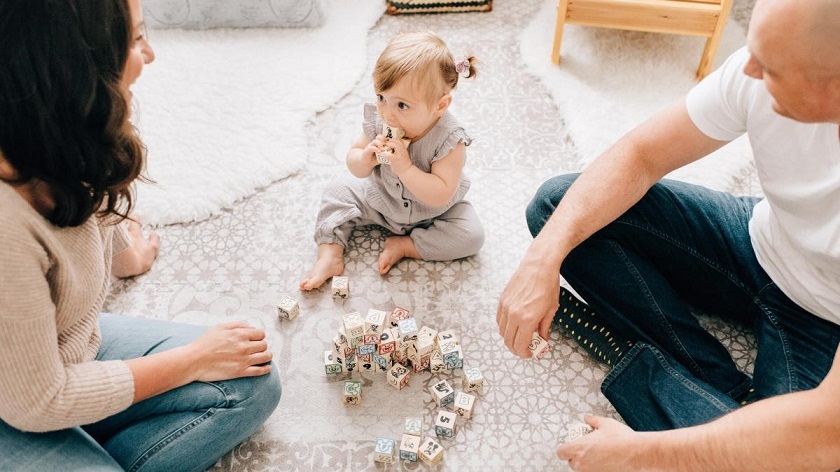Therapy for parents found to cut diagnosis of autism spectrum disorder by two thirds.
Photos above: Parents in the study were given a five-month course aimed at improving the communication between them and their children. (ALAMY)
Article by Kat Lay, the Health Editor of the Times, issued on Monday September 20, 2021:
Giving therapy to the parents of babies showing potential signs of autism reduced the babies’ chance of going on to have the condition diagnosed by two thirds, according to a new study.
At age three, 6.7 per cent of children targeted by a five-month course aimed at improving communication between parents and their infants had autism spectrum disorder (ASD) diagnosed. In a comparable group who did not take part the figure was 20.5 per cent of children.
It is the first time that such an improvement has been shown worldwide and researchers said that it could have a “gobsmacking” impact.
Between 1 per cent and 2 per cent of people have autism so more than 10,000 infants a year in the UK could benefit.
The trial involved babies in Australia aged nine to fourteen months who were selected for inclusion because they were showing potential signs of autism such as differences in spontaneous eye contact, social gestures, imitation or how they responded to their name.
The research team was led by Professor Andrew Whitehouse of the University of Western Australia, and included Professor Jonathan Green of the University of Manchester. The treatment is known as iBASIS-VIPP.
Green said: “These findings are the first evidence that a pre-emptive intervention during infancy could lead to such a significant improvement in children’s social development that they then fell below the threshold for a clinical diagnosis of autism. Many therapies for autism have tried previously to replace developmental differences with more ‘typical’ behaviours. In contrast, iBASIS-VIPP works with each child’s unique differences and creates a social environment around the child that helps them learn in a way that was best for them.”
He emphasised that it was “not some miracle cure that makes them neurotypical” but said that it had improved the children’s social engagement and reduced stress in their lives. The study, published in JAMA Paediatrics, also demonstrated improvements in how the children interacted with others and a reduction in repetitive movements and unusual sensory interests.
The therapy involves videoing the children interacting with a parent. The parent then watches the video with a therapist who helps them to understand how the child might be communicating with them in atypical ways.
Green said: “The theory behind the intervention is how crucial these early caregiver-infant interactions are to brain and social development.” He said that differences in the brains of autistic children, present from infancy, could have a subtle effect on those early social interactions, leading to parents and babies getting “a bit out of sync”.
“This can lead parents to be highly perplexed by how to communicate, and understand their baby. And for the babies, they are getting less simple and useful feedback from parents because of that,” he said. “We think that these early social interaction difficulties can then cascade and amplify existing problems for the baby into an autistic trajectory.”
The researchers assessed 89 children at the start of the study, after the therapy period, and at ages two and three. The children who fell below the diagnostic threshold for autism still had developmental difficulties but the researchers said: “By working with each child’s unique differences, rather than trying to counter them, the therapy has effectively supported their development through the early childhood years.”
Use of the therapy by the NHS would require changes to how support to families with autistic children is provided. Many complain that they cannot access help without a formal diagnosis.
Whitehouse said that follow-up of study participants in later childhood, when the behaviours for autism may be more apparent, would be crucial to determining the longer-term significance of the video intervention.
He said, however, that he hoped that intervention during a time when the brain was rapidly developing “may lead to even greater impact on developmental outcomes in later childhood”.
Dr Marie Schaer, assistant professor at the Faculty of Psychiatry, University of Geneva, said intervening “before the onset of full-blown autism” would represent “a paradigm shift” in the field. “ASD is a neurodevelopmental disorder, often associated with increasingly deviant developmental trajectories as the child grows,” she said. “The increasing deviance from typical development explains why it is often easier to diagnose autism in children older than three, when the signs are more prominent. But it also explains why, if we intervene as early as possible when autism is diagnosed, we can most efficiently narrow the gap.”
Tim Nicholls, head of policy, public affairs and research partnerships at the National Autistic Society, said that some autistic people and their families might be concerned at the suggestion that the intervention could have an impact on “autism behaviour severity”. He said: “Autism is not a disease and not something that should be cured or lessened.”

